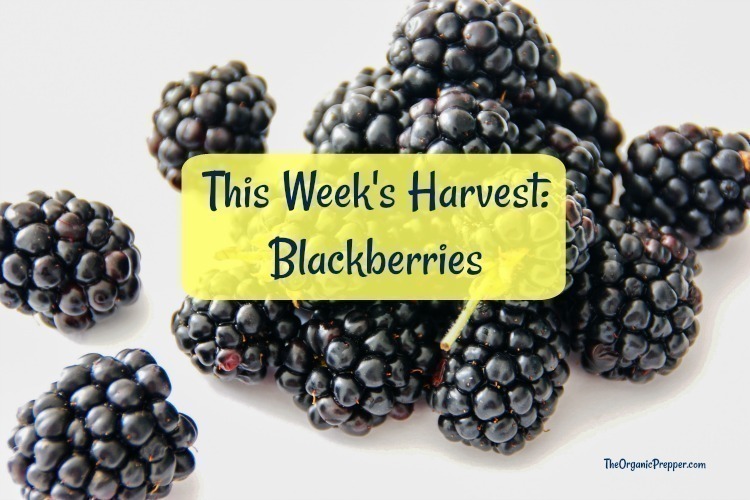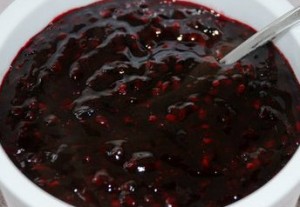If you're new here, you may want to subscribe to my RSS feed. Thanks for visiting!
Author of Be Ready for Anything and Bloom Where You’re Planted online course
When I lived in California, blackberries grew wild to the extent that they were considered an invasive plant by many people. An untouched patch of blackberry bramble ran amok in the backyard and the fruit was a sweet daily bounty throughout late June and early July. If you don’t have them growing in your own garden, look for them right now at your local farmer’s market. (Find a market HERE)
Some blackberry trivia
Ancient civilizations did not cultivate blackberries, rather they gathered them from the wild. Folklore in the UK claims that blackberries belong to the devil after Michaelmas and thus should not be picked after Oct. 11. Early explorers of North America found them to grow prolifically in the Southern colonies and in California. They are a native plant on every continent except for Antarctica and Australia. Other names for blackberries include brambleberries, dewberries, and thimbleberries.
Blackberries are packed with nutrients.
Any fruit that is particularly rich in color is also particularly rich in nutrients, and the humble blackberry is no exception.
- Blackberries are loaded with minerals, particularly potassium, phosphorus, iron, magnesium, and calcium.
- Blackberries have one of the highest levels of antioxidants found in any fruits. Antioxidants improve the immune function and help lower your risk of developing cancer.
- Blackberries are high in vitamin C, vitamin K, and folic acid.
- The seeds of blackberries hold the key to important nutrients like omega-3 and -6 fatty acids, as well as some protein, dietary fiber, carotenoids, ellagitannins, and ellagic acid.
- One cup of blackberries contains 62 calories, 13.8 grams of carbs, a whopping 7.6 grams of dietary fiber, and 2 grams of protein.
All parts of the blackberry plant have long been used for their medicinal properties.
- Blackberry roots are astringent and can be used as a treatment for diarrhea.
- The berries themselves contain high levels of salicylic acid, which gives them similar properties to aspirin, such as pain relief and fever relief.
- The leaves can be chewed or made into a tea to treat mild inflammation of the gums or sore throats.
- Blackberry juice is a soothing treatment for hemorrhoids.
Wondering how to eat and preserve your blackberries? The following information is an excerpt from my PDF book, The Seasonal Kitchen Companion. Be sure to grab your copy to make the most of your summer bounty.
Here are some ways to use fresh blackberries.
Many of the ideas here can be used interchangeably with blackberries, boysenberries, or raspberries, depending on your local harvest.
Gently wash your blackberries in cool water and put them in a colander to drain. Use them immediately after washing them for the best texture.
- Blackberries make a wonderful addition to a fruit salad, a topping for ice cream or shortcake, or as a delicious, finger-staining snack.
- Add blackberries to iced tea or lemonade for a refreshing summer drink. Smash them gently with a fork to release more blackberry flavor into the drink.
- Substitute blackberries for blueberries in your favorite muffin or pancake recipe.
Or you can make cobbler. Because who on earth doesn’t love hot cobbler topped with ice cream?
Blackberry Cobbler
Ingredients
- 4 cups of fresh blackberries (or thawed previously frozen blackberries)
- 1 cup of turbinado sugar, plus extra to sprinkle on top
- 1/2 cup of butter
- 1 cup of flour
- 2 tsp of baking powder
- Dash of salt
- 1 cup of milk
- 1 tsp of vanilla extract
- 1/8 tsp of nutmeg
Directions
- Preheat the oven to 375 degrees F.
- Melt butter in the bottom of your cast iron frying pan.
- Top berries with sugar, then mash them with a potato masher.
- In a large mixing bowl, sift together flour, baking powder, nutmeg, and salt.
- Stir in the milk and vanilla.
- Pour this mixture into the melted butter in your frying pan and then stir well to combine.
- Top the cobbler dough with berries, juice, and sugar mixture.
- Bake at 375 for 45 minutes or until the top is golden and a toothpick inserted into the dough comes out clean.
Top with ice cream or fresh whipped cream.
Blackberries can be preserved.
There are all sorts of ways to put blackberries back to enjoy over the winter.
Freezing
To freeze fresh blackberries, wash them gently, then pat them dry. Place them on a cookie sheet in a single layer and place this in the freezer for two hours. Store the frozen berries in large freezer bags.
Canning
Blackberries may be canned in syrup for use later in pies, cobblers, or crisps. The canned berries also make delicious ice cream or pancake topping.
Syrup Ingredients
- 1cup of crushed blackberries (you can also puree them)
- 8 cups of water
- 2 cups of sugar
Syrup Directions
- Bring the water to a boil
- Stir in the sugar and crushed berries
- Continue to stir until all of the sugar is dissolved and the crushed berries are well incorporated.
This is the raw pack method for canning blackberries. Berries are very delicate and do far better when canned using this method.
Ingredients
- Blackberries
- Lemon Juice
- Syrup
Directions
- Add two tsp of lemon juice to the bottom of each sanitized jar.
- Place the berries into your jars, allowing 1 inch of headspace for expansion.
- Cover the berries with boiling syrup. Wipe the rim and cap your jars with snap lids and rings.
- Process in a pressure canner for 30 minutes, adjusting for altitude.
This and other canning recipes can be found in my book, The Prepper’s Canning Guide,
Here’s how to make blackberry jam.
Ingredients
- 8 cups of blackberries
- 1 packet of pectin + ¼ of a package (I like to use the no-sugar-needed, but then still add sugar – just less!)
- 4 cups of sugar (I use organic turbinado sugar)
- 1 tbsp of lemon juice (you can use more if you want the jam to have a lemon-y flavor – up to 1/4 of a cup)
Directions
- Prep your blackberries by washing them. Some people like to remove the seeds but this is a matter of personal preference.
- Smush your berries. You can do this with a potato masher, food processor, blender or food mill. Some people like to puree them and have a smoother jam and others like chunkier jam – it’s also up to personal preference.
- In a small bowl, use a fork to mix a ¼ cup of the sugar with one packet of pectin.
- In a saucepan, stir the fruit, lemon juice, and pectin together well.
- Bring the mixture to a boil over medium heat, stirring frequently.
- Once it is boiling, stir in the sugar and return to a boil for one minute.
- Test your jam…(see below!) If it isn’t the proper consistency add the other quarter packet of pectin, simmer for another minute, then retest.
- Ladle the jam carefully into your awaiting sanitized jars, wipe the rim and cap your jars with snap lids and rings.
- Process in a water bath canner for 10 minutes, adjusting for altitude.
Jam Making Rule of Law:
Always test your jam! How?
You do this by keeping a spoon in the freezer – to test, drip a bit of the hot jam into the spoon to allow it to quick cool – the consistency it reaches is the consistency your finished product will be. At this point, I nearly always end up adding another 1/4 – 1/2 package of pectin – I use the cheaper pectin to “top it up” – return to a simmer for a couple of minutes and test again. Omitting this step may result in a very tasty ice cream topping or waffle syrup, but not jam!
What do you think?
Do you grow blackberries in your yard? What do you like to make with blackberries? Please share your thoughts in the comments.


















An ol trick some know…..Birds LOVE blackberries, they also FEAR snakes. We used to put a rubber snake, on the blackberries, not one bird ever ate them again….mmmmmmm blackberry cobbler.
Just a small correction; Dew Berries and Thimble Berries are a couple of totally different plants, resembling the Raspberry more than the Blackberry.
Daisy: I’m so glad you have arrived at your new home & have a gift from heaven…blackberries. Growing up on the west coast I learned to love them. My grandma had a big patch. One of my sadnesses is that they don’t grow on the Canadian prairies where I now live. Those you buy in the store are not worth it. I think they inject each one with a special sourness.
I hope you settle in well and find all to your liking out west.
Your article reminds me of our blackberries in Oregon.
‘Himalayas’ and ‘Evergreens.’
They grew wild everywhere. What a treat!
Just be sure not to pick next to the numerous blackberry patches next to a highway. They might have been sprayed. Even if not this year, then in the previous year, and lots of residue may still be there.
Also, you should check into using low methoxyl pectin for jam – no sugar needed. Pomona’s Universal Pectin is the only brand I know of. Just note that, since little or no sugar is used, more fruit is needed for the same amount of jam when using sugar.
I’ve been making a lot of blackberry jam recently. I make freezer jam, so there’s no need to add pectin, just blackberries, sugar, and a pinch of salt. The blackberries I use are from the store, not so blessed as you, finding them growing wild; so due to their blander flavor, I add some ground ginger to taste, while the berries are cooking, and a little chopped crystallized ginger after I’ve turned off the heat. It makes the most delicious jam.
never heard blackberries called thimbleberries before. must be a regional thing. here in the pacific northwest, there is a native thimbleberry, which is a relatively non-aggressive in the bramble family. its berries are dusty red and look lie a somewhat flattened raspberry. they a somewhat blander than a raspberry, but distinctly edible.
Interesting. I just printed out a recipe for BLACKBERRY BBQ SAUCE. I will be making it for our ribs that I will be BBQ’ing.
When I lived in California, blackberries were an invasive weed if not carefully cultivated, but boy were the fruits good eating. I never got the berries home before eating them.
One thing to watch for is that the berries turn black days, up to a week, before they are ripe. Unripe berries are sour. Most berries bought in stores are unripe. Therefore I don’t buy blackberries in a store.
Blackberries are not the only fruit that are unripe when sold as fresh in stores. The last time I bought “fresh” strawberries, they were so sour I couldn’t eat them. I had to prepare them as part of another recipe with lots of honey to cover their sourness.
I miss those ripe blackberries since my job moved me out of California and they don’t grow here.
I live in the UK and that’s the first time ive ever heard that about the devil and October, in fact this year it was so dry and hot I didn’t go and pick any until October, and they were still small and hard! I probably is generally true not to bother picking blackberries in October because it is so cold and wet here they just mould which is not good for preserving.
DO YOU NEED ANY TASTE TESTERS?